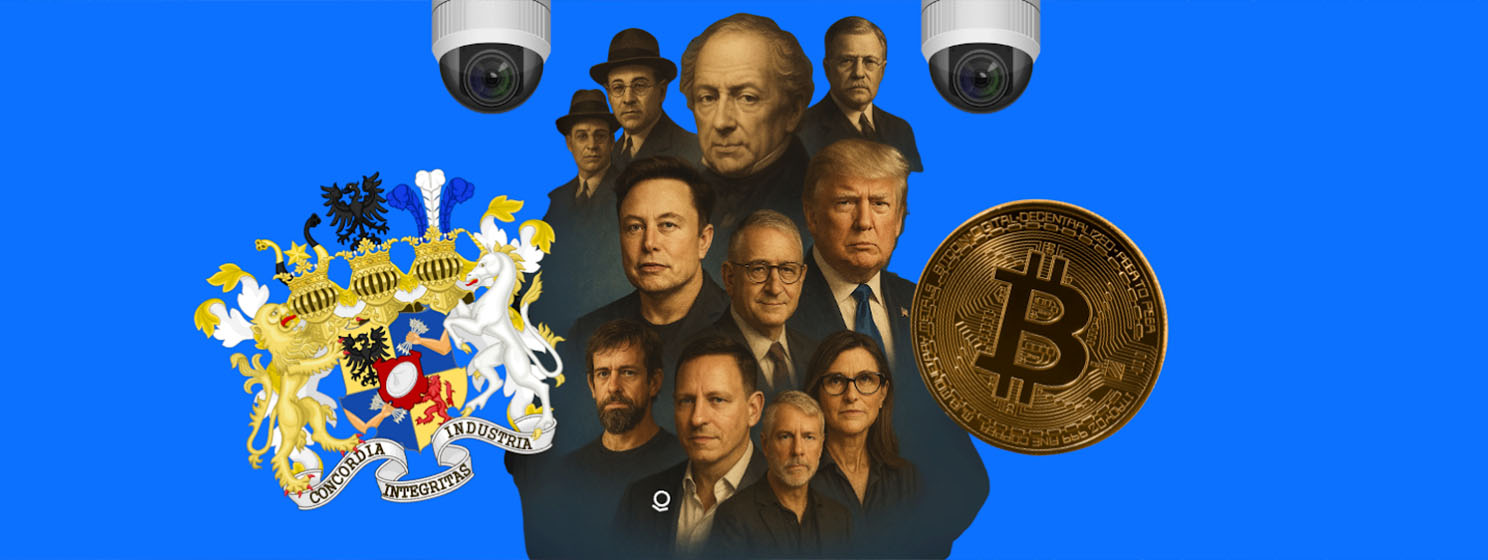|
Getting your Trinity Audio player ready...
|
- Money controls everything
- Rothschild’s financial template
- US the center of power for new age
- Moe Dalitz’s casino empire
- Electromagnetic minds
- From Stanford to Silicon Valley
- The rise of Bitcoin
- Hijacking Bitcoin
- Suppressing Satoshi’s vision
- The last firewall
- Call to action
For many years, I have talked about the hijacking of Bitcoin, the ensuing civil war, and the caricatures of “Greg” and “Mastercard” (NASDAQ: MA) because they are easy for readers and listeners to understand. But, I think it’s time to be very clear that Gregory Maxwell and Mastercard are little more than symptoms of a disease and relatively small pillars of a system that is much more correlated and intertwined than we want to think. The problem is that explaining it requires long form, patience from the reader, and a lot of digging.
Small blockers aren’t a monolith. Neither are big blockers. In this article, I intend to show how intelligence agency officers, military, banking, finance, and government officers aren’t a monolith either. But they also aren’t very deeply separated. They share many of the same people, ideas, and policies, and have revolving doors among them. I summarize them, often, as “Big Tech, Big Banks, and Big Gov,” but the next time someone asks, “was it the NSA, CIA, Silicon Valley, crypto-anarchists, or the Federal Reserve who hijacked Bitcoin?”
You can just answer “yes.”
The truth is there is something very wrong with how the world has been knitted together since World War 2, but the rotten fruits we are harvesting from Musk, Thiel, and Trump were planted before the telegraph was cutting-edge technology.
It’s easy to think that trio is new and revolutionary tweeting Dogecoin memes on X or throwing millions behind culture war Senate candidates to usher in a new wave of surveillance capitalism or when a casino mogul turned populist president, promises to drain a swamp but then reneges on all the transparency within six months of inauguration.
This is a story that began centuries ago, when controlling money meant controlling everything, and it continues today on the screens in your hands and the servers in data centers under mountains. It is the story of how Big Banks, Big Tech, and Big Government fused into a single sprawling machine, turning citizens into free-range serfs on a plantation that remains invisible to anyone who doesn’t push the envelope. The only difference in today’s authoritarian systems is that people used to get thrown in cages, slaughtered, viciously overthrown, etc… Today, everything is a “soft” version of what came before. Soft coups, soft imprisonment, soft enslavement, soft wars… Bitcoin is different because it is hard, and understanding that may be the last chance to break free from our soft cages.
The Rothschild template
The modern playbook for financial control was written in the late 1700s by a family of farmers turned pawn shop owners, turned bankers. By the early 1800s, the Bauer family had become Lords under a red-shielded crest (or Roth-Schild, in German). Nathan Mayer Rothschild built a pan-European banking empire that didn’t merely lend money to monarchs, but anticipated wars, underwrote both sides, and leveraged a network of private couriers and pigeons to obtain news faster than any government.
When Wellington defeated Napoleon at Waterloo, Rothschild agents delivered the news to London days before anyone else. Nathan quietly dumped British bonds, then repurchased them at panic lows, cementing his family’s fortune and proving that whoever controlled information controlled markets, and whoever controlled markets controlled nations.
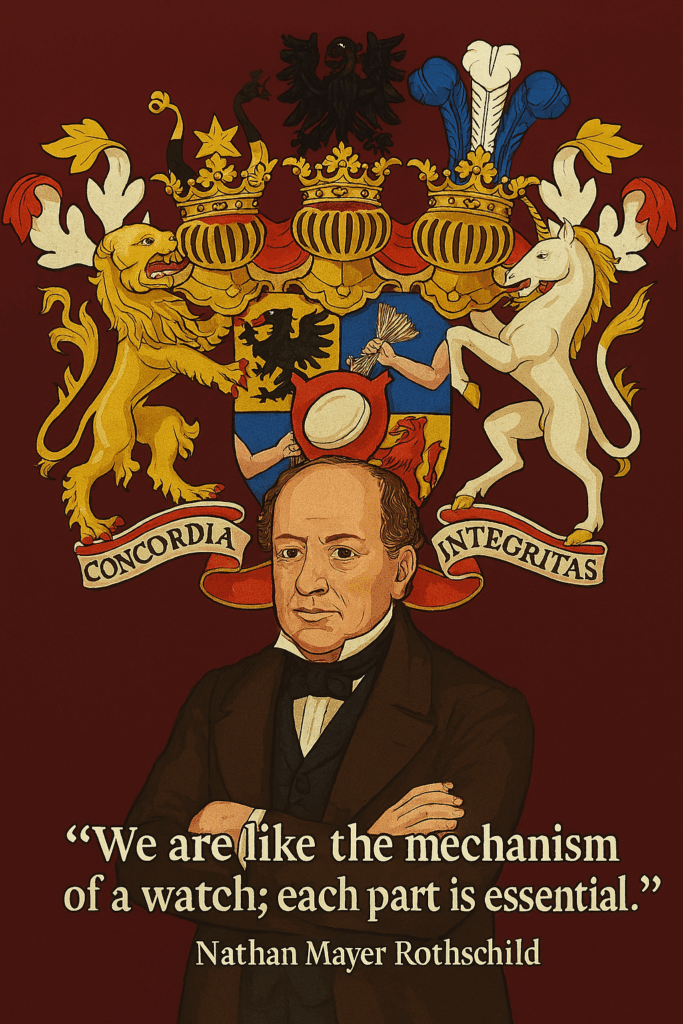
Paul Julius Reuter, a former Rothschild carrier pigeon handler, founded Reuters by mid-century. It soon became the principal news wire of the financial world and was heavily patronized by NM Rothschild and Sons investment bank before blowing up as the official wire service of Europe and the United Kingdom.
Across the Atlantic, the Associated Press was formed, consolidating narrative power in the hands of the largest media agencies, who use AP as a non-profit conglomerate to share the opinions of the largest companies in “the news.”
Finance and information had become two blades of the same scissor by the time of the Mexican-American War, and narratives set in board rooms became the official written history of the Western Hemisphere thereafter, thanks to “the news” being whatever the big corporations decide it is.
The consequences of this can be illustrated in Standard and Poors’ refusal to downgrade the credit of the subprime lenders of Wall St before the 2008 global financial crisis under the auspice that the news of the credit downgrade would itself cause the collapse; suggesting that big media and big finance may be too closely intertwined to be useful when they’re actually needed.
Industrialists and arms dealers
As the 19th century lurched into the 20th, global cartels of industrialists and arms makers grew fat on the machinery of war. World War I and II marked the era when the Rothschilds lost much of their primacy in Western finance, scattered by Nazi oppression, the war, and then ultimately eclipsed by growing rivals. Yet while the family’s grip loosened, their blueprint endured: central banking, industrial espionage, and the seamless fusion of state and permanent war economy. New players simply stepped into the Rothschild mold, turbocharging these strategies for an age of global surveillance and endless conflict.
The post-war era also cemented the rise of the United States as the center of power for this new age. With the U.S. having essentially zero industrial damage or scars of war, and a newly booming economy due to massive investment in both infrastructure and a population emboldened by the victory and cultural shift to American exceptionalism, the United States was primed to dominate.
This domination was formalized in 1944 at Bretton Woods. The dollar was pegged to gold, and every other currency pegged to the dollar. The U.S. Federal Reserve effectively became the world’s central bank, stewarding not just American prosperity, but global dependency. In 1971, Nixon ended the gold peg, unleashing fiat currency maximalism.
Money was no longer restrained by physical collateral; only by political will and printing presses.
Managed wisely, the Federal Reserve could plan investments with commercial and investment banks, government investment strategies, technology, and military excursions for profit. The inflation that would come from printing could be outpaced by growth in the American economy and debts repaid by profits generated in the cycle.
For the most part, this worked. Soft money created a tremendous boom in technology, infrastructure and wealth for the American people—especially if they were lucky enough to own any hard assets, which were distributed cheaply in the form of real estate to WWII veterans and their children, making for a strong economy of ownership and creating the American middle class.
But it was also fragile, cyclical, and the central planning of the economy by big finance and big government created the opportunity to build the ultimate plantation: infinite leverage, infinite debt, and infinite opportunities for control.
They just needed a catalyst or two.
Lansky’s neon laboratory
Meanwhile, in postwar Las Vegas, Meyer Lansky, the mob accountant who built the Mafia’s Murder Inc. into a global money laundering empire, was busy innovating. Working with Moe Dalitz, a former rum-runner turned casino kingpin, Lansky transformed Vegas into a giant lab for behavioral manipulation. They discovered that painting over windows, removing clocks, and blasting bright lights kept gamblers in a timeless haze.
Feeding them steaks and booze sealed the deal and made gamblers profitably addicted to the atmosphere of the casino. That addiction created liquidity, and that liquidity created the means for incredible amounts of money laundering in cash when the world was quickly moving toward electronic means of accounting.
Lansky famously set up sophisticated communications taps that gave him visibility into Federal Reserve movements: an underworld front-run on monetary policy. Vegas was not just a crime hub; it was a prototype for simultaneously hacking human psychology and financial markets, and the CIA was taking notes.
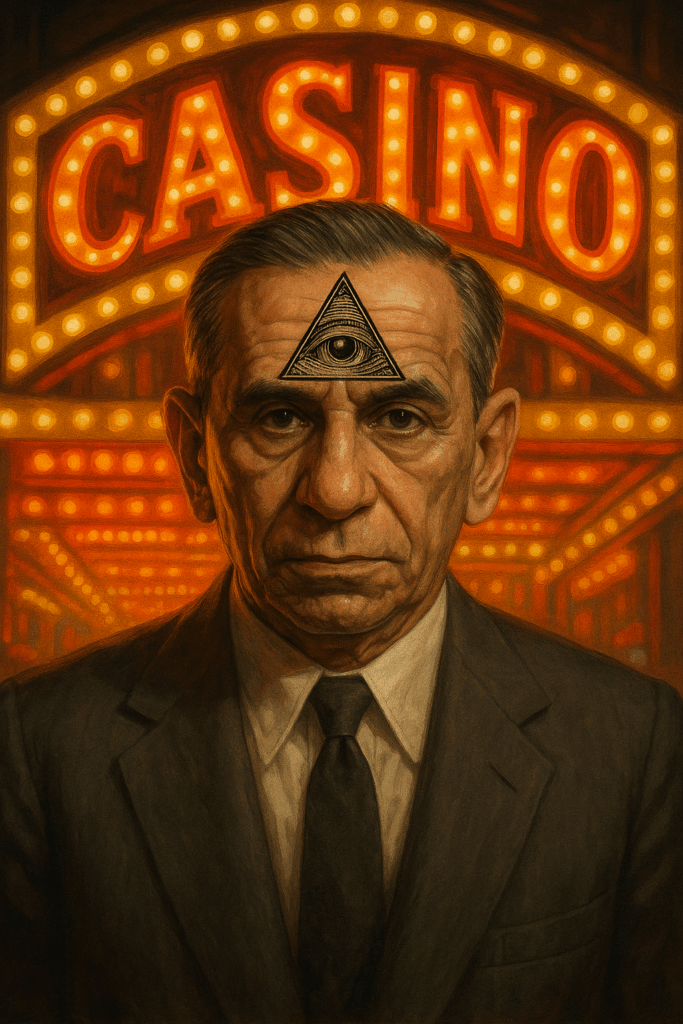
MK Ultra, the infamous mind control program, is mostly remembered for LSD. But it quickly expanded into electromagnetic experiments, light pulsing, and frequency entrainment. The casino was a perfect model: override natural rhythms with artificial light, distort perception with alcohol and time loss, and rake in profits.
The intelligence community and then the Department of Defense quickly understood that Lansky and Dalitz had built a behavioral Ponzi scheme that was as scalable as any multinational.
Furthermore, while mind-altering drugs, torture, and brutalism made for rogue assets that were difficult to control, the soft control of the populace through their televisions and cultural experiences made the assets of the plantation—the people—easier to control without the need and risk of large-scale chemical experimentation.
Delgado, Becker, and the electromagnetic mind
Enter Dr. Jose Delgado, the Spanish neuroscientist who, a generation before Neuralink, implanted electrodes in bull brains and famously stopped them mid-charge with a radio signal. Delgado proved that you didn’t need to control an entire brain if you could tune a few neurons. Just the right circuit, and you owned the creature.
Around the same time, Dr. Robert Becker, an orthopedic surgeon, mapped the tiny direct-current electric fields that govern how bones knit and tissues regenerate. The Pentagon funded his work after noticing Navy pilots exposed to avionics developed sky-high cholesterol and collapsed vitamin D cycles. The conclusion: electromagnetic environments and distance from the circadian rhythm rewrote biology at the cellular level.
The casino was the seed. The lab tests were the sprout, and the budding military-industrial complex was quickly scaffolding the modern digital plantation with control of media, scientific research, finance, and the blue light full of numbing entertainment that was making its way into everyone’s homes

From Stanford to Silicon Valley’s Panopticon
Much of this research funneled through the Stanford Research Institute (SRI), a quiet outpost of Cold War spook experiments. From there emerged the Silicon Valley ethos: a fusion of military contracts, university labs, and private venture capital that blurred lines between spycraft, consumer tech, and behavioral economics.
This is the world that gave us the MIT Digital Currency Initiative via their various media labs and financial entanglements with private financiers and intelligence community participants.
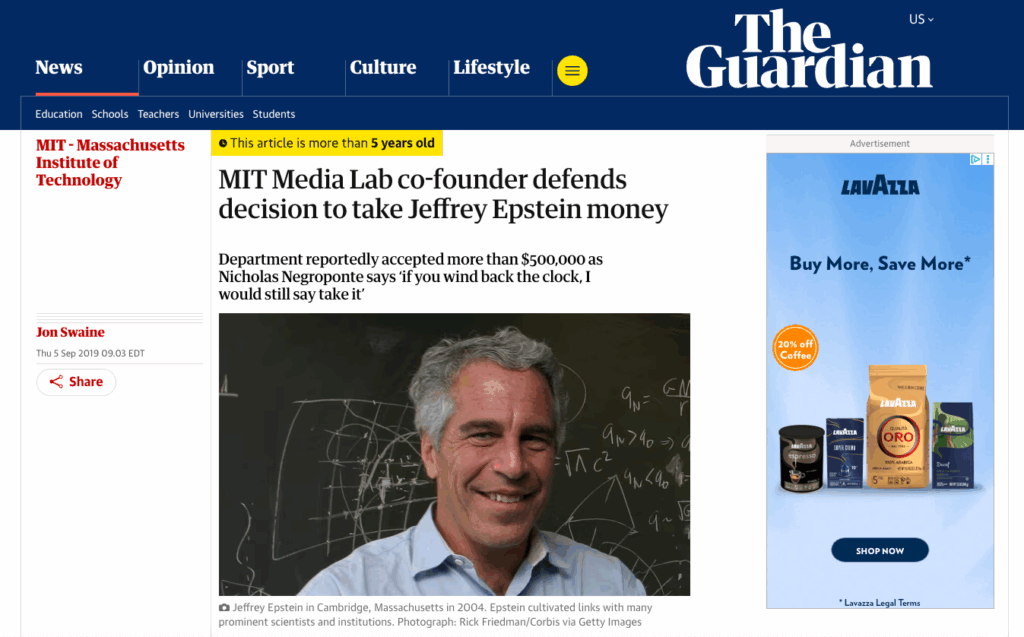
It also gave us Peter Thiel (PayPal [NASDAQ: PYPL] co-founder and Palantir architect) who turned Big Data into the ultimate counterinsurgency tool, selling it to governments under the banner of “knowledge management.” It produced Elon Musk, who absorbs billions in public subsidies for rockets, cars, and Neuralink brain chips that read like Delgado’s wireless experiments reborn in the Matrix. Jack Dorsey, the bearded anachronist shaman of payments and social media, who quietly built Twitter into the globe’s emotional steering wheel and handed the reins to big government censors before selling it to Musk and pivoting to Bitcoin (but the wrong version, as we’ll see).
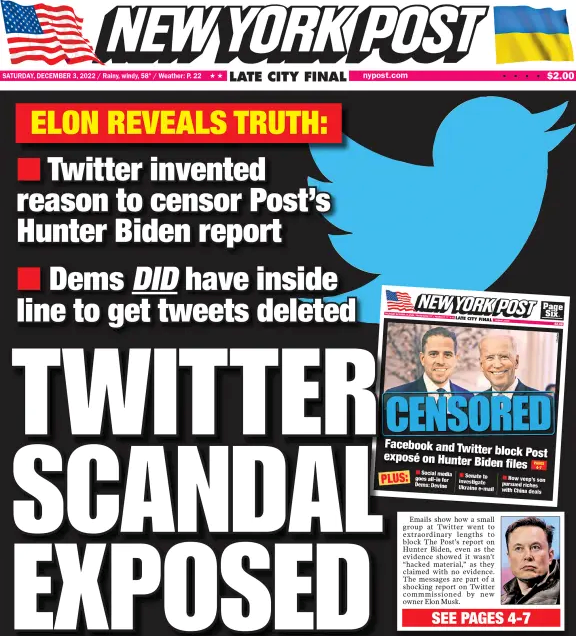
It also gave us a President who learned everything he knows from running a casino empire and mastering the art of social engineering via social media. On promises of “draining the swamp,” he brought in a Vice President, a direct protege of Peter Thiel, and advisors with deep roots in the Silicon Valley surveillance economy.
It’s no wonder the swamp is still full, but Palantir gets juicy new contracts to surveil American citizens while Trump launches memecoins in a decentralized casino built on Solana blockchain.
This was all underwritten by the same families, funds, and secretive institutions that once funded trench warfare and military bonds. Big Banks provided capital. Big Tech built the tools. Big Government enforced the architecture, and together, they created the cyclical economy that they all needed to stay in power and create the illusion of wealth.
Bitcoin: The last rebellion
But the plantation had a crack in its wall.
In the late 1970s, David Chaum, a cryptographer with a libertarian streak, proposed anonymous digital cash, seeing already that banks and states would unite to track every transaction. Many others followed with tooling to help make the individual more secure and more private. Phil Zimmerman’s PGP, Timothy May’s Blacknet, Len Sassaman with encrypted email and reputation protocols, Hal Finney building PGP 2.0 and reusable proof of work as a SPAM filter…
There were dozens of attempts at creating a digital cash so that free people could have a free money separate from the central bank state, the military industrial complex and its tentacles into everywhere, but they were plagued with centralization risk and trust issues because the cypherpunk community was also embroiled and entangled into the mess of white, gray and black hat activities, so they couldn’t trust each other not to be crooks or Feds, double agents or corporate shills.
Due to trust problems, every digital cash or cryptocurrency attempt failed until Bitcoin.
By 2008, the world had seen the booms and busts of multiple cycles, multiple massive and increasingly complex wars, the rise of asymmetric warfare, and more. Against that backdrop, Bitcoin was born from a stew of NSA hash functions, academic cryptography, cypherpunk manifestos, truly free market incentives, and the complex web of internet culture. Its genius was simple: by linking energy (proof of work) and time (block intervals) into an unforgeable public ledger, it turned computation into a monetary asset. No trust, no leverage, no threats. Just proof of work and public attestation of the truth; auditable by anyone.
The ledger of account, humanity’s oldest technology, was now decentralized and incorruptible—at least in theory. It was, as Satoshi Nakamoto wrote, “a chain of digital signatures” that abstracted value, energy, and time into money, and maybe poked the bubble created by hundreds of years of meddling and corruption.
The hijacking: Silicon Valley’s second gold rush
This was intolerable to the plantation masters. Reid Hoffman (LinkedIn, PayPal), Marc Andreessen (Netscape, Facebook board), Peter Thiel, and the sprawling VC apparatus of Blockchain Capital, Digital Currency Group, Digital Garage, Baillie Gifford, AXA Strategic Ventures, and CME Ventures swarmed Bitcoin. MIT, which is a friendly nest for CIA projects, provided academic cover. They knew Bitcoin was technologically secure. It couldn’t be cracked, hacked, or back-doored. It couldn’t be brute-forced or censored directly, but the weak link in any system is always people. People run the Bitcoin GitHub repo. People mine the blockchain. People run the startups that use it and trade it. Those people were the target.
These people were pitched to participate in Bitcoin’s inevitable progress, but the real aim of investor capital was to neuter it: scale it down, throttle its capacity, and force all meaningful transactions onto private side-chains controlled by the same banks and data oligarchs who control the old world.
Thus, the Bitcoin Civil War erupted. Bitcoin’s true believers resisted predatory capital and social engineering campaigns while companies like Coinbase (NASDAQ: COIN), Kraken, Bitfinex, Blockstream, Lightning Labs, Chaincode Labs, and others let themselves be bankrolled by this old world clique.
They took over Bitcoin Core (BTC) and strangled it with propaganda about the need for throttled throughput.
They sold the public on “digital gold” as a sterile warehouse asset that “will make you rich” while keeping the global programmable ledger neutered.
It was a brilliant soft coup d’etat
The companies like Coinbase and Blockstream that compromised their values and took in venture capital grew into multi-billion-dollar darlings, rebranding Bitcoin as a global casino, are now sending back into the military-industrial complex!
It’s just like Lansky’s casinos. They facilitate the facade of business to test out people’s behavior while committing them to the addiction of the system, pumping up liquidity, and selling services to Big Tech, Big Banks, and Big Government. The new neon lights are price charts, dopamine cycles, hideous influencers, and endless “number go up” speculation.
Meanwhile, side chains and off-chain solutions were readied alongside dark order books and market makers to facilitate illegal trade and money laundering for the insiders and spooks while managing the controlled rails to herd meaningful, taxable commerce of the average person back under banks and regulators.
This occurred at the cost of Bitcoin ever becoming a useful asset in real, disruptive commerce. The fiat money-printing cycle now rewarded coin holders into satiety, compliance, and turned them into a soft marketing wing, much the same way as cheap real estate was weaponized to turn baby boomers into advocates for constant growth in taxes and welfare.
All it took was for people to feel like they had left the rat race to become the foot soldiers of maintaining the trajectory of the plantation.
But a splinter chain, Bitcoin SV (BSV), survived various rounds of cullings. It preserved Satoshi’s original vision: unlimited scale, protocol stability, micropayments, and on-chain data ownership. In other words, the true Web3 of self-sovereign data, peer-to-peer apps, and unstoppable finance, all tied directly to the energy-time ledger that makes Bitcoin unique.
Instead of fast gains in wealth, BSV exclusively offered the world a free and nearly costless access to a global database tied to a hard money system. But it also offered the hard truth of hard work to a people who had become addicted to soft money and neon lights.
And that’s only the first part of the challenge with BSV.
The suppression of BSV
No surprise, then, that the empire fights BSV at every turn. Jack Dorsey’s companies block their tickers and hashtags. Mark Zuckerberg’s Meta (NASDAQ: META) shadowbans BSV content. Michael Saylor, a newly minted “Bitcoin” evangelist, conspicuously pushes BTC’s digital gold meme while ignoring Bitcoin’s computational utility and feeds the gamblers’ addiction with new financial vehicles like “Bitcoin Treasury Stocks.”
Exchanges delist BSV under regulatory excuses. Payment processors refuse integration. They might even kill their supporters for getting too close to liberating the people.
Why?
Because BSV is dangerous to the plantation, it breaks Big Tech by enabling data ownership and direct monetization, bypassing platforms. It breaks Big Banks by enforcing scarcity through proof of work, making a money that can’t be printed by decree. It breaks Big Government by providing a transparent ledger for voting, budgets, and identity systems that don’t require state attestation.
The last firewall before technoserfdom
For hundreds of years, from Rothschild pigeons to Reuters wires, from Lansky’s casino labs to MK Ultra’s frequency experiments, from Palantir’s social graphing to Neuralink’s promise of wireless brain taps: the same triangle of Big Banks, Big Tech, and Big Government has refined the art of managing populations through money, media, and mind.
BSV is the first technology since the printing press that genuinely threatens this triangle at a fundamental level. It is a ledger anyone can write to. It is money tied to physics, not policy. It is a data layer immune to censorship. It promises a world where your vote, health record, business contract, music royalties, and everything else is secured by the same transparent protocol and cannot be intimidated or social-engineered by the shifting whims of unelected corporate boards or opaque state agencies.
The plantation will not give up easily. They haven’t given up on keeping Bitcoin hijacked and under their control. Remember, they have had centuries of practice. They will dismiss BSV as a scam, obscure it with noise, or starve it of liquidity through pressure campaigns.
But the plantation’s greatest asset is your inertia. Your willingness to stare at blue-lit screens that siphon your dopamine. Your resignation to debts that rise faster than your pay. Your fatalism in the face of wars spun up by think tanks whose logos are older than your grandparents.
The call to action
It does not have to be this way. For every corrupt agent, investor, and politician, there’s a good person looking for ways to make the world a better place. You stand at the same crossroads as every generation that faced a new feudal order, from serfs under steel visors to colonists under mercantilist tariffs. You can learn how this system was built, how fake news isn’t new, how banks rig markets, how governments launder consent… We cannot “trust the plan” or sit back and let anyone else fight these battles for us.
We must opt out of the mind control and opt into a freer future, and one good way to start is by building, using, and transacting with BSV.
By anchoring your digital life to a chain that anyone can audit, no one can censor, and no consortium can inflate.
The chains are digital now, but so is the key.
Break free!
Watch: How do you build a successful ecosystem? Bring blockchain to the builders!

 12-25-2025
12-25-2025 
